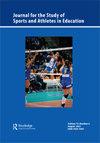(In)equity in athletics: U.S. antidiscrimination law and the white, middle-class advantage
IF 1
Q3 EDUCATION & EDUCATIONAL RESEARCH
Journal for the Study of Sports and Athletes in Education
Pub Date : 2022-04-07
DOI:10.1080/19357397.2022.2060699
引用次数: 1
Abstract
ABSTRACT Equity in Athletics, Inc., v. Department of Education (2011) questioned whether schools could cut men’s sports for Title IX compliance. The case uniquely wedded racial and gender antidiscrimination precedents to argue Title IX harms men and therefore is unconstitutional. The courts disagreed and validated Title IX’s constitutionality. We argue this case did far more than endorse Title IX. Equity in Athletics showcases how antidiscrimination laws failed to redress the roots of racism, capitalism, and sexism all while ignoring harms done at the intersections. We use Crenshaw’s (1988, 1989, 1991) intersectional legal framework – single-axis, essentialism, and restrictive view of equity – to analyze Equity in Athletics. An intersectional reading of the case showcases three areas of the law – constitutionality tests, quotas, and segregation – that increase the athletic advantages for white, middle-class cis-gender girls and women at the expense and exclusion of lower-income, Girls and Women of Color, and transgender athletes.体育运动的公平:美国反歧视法与白人中产阶级的优势
摘要:股份有限公司诉教育部(2011年)的体育公平案质疑学校是否可以为了遵守第九条而削减男子体育项目。该案独特地结合了种族和性别反歧视的先例,认为第九条伤害了男性,因此是违宪的。法院不同意并确认了第九章的合宪性。我们认为,这起案件远不止支持第九章。《田径公平》展示了反歧视法如何未能纠正种族主义、资本主义和性别歧视的根源,同时忽视了交叉路口造成的伤害。我们使用克伦肖(1988、1989、1991)的交叉法律框架——单轴、本质主义和限制性公平观——来分析田径运动中的公平。对该案的交叉解读展示了法律的三个领域——合宪性测试、配额和种族隔离——这些领域以牺牲和排斥低收入、有色人种女孩和妇女以及跨性别运动员为代价,增加了白人、中产阶级顺性别女孩和妇女的运动优势。
本文章由计算机程序翻译,如有差异,请以英文原文为准。
求助全文
约1分钟内获得全文
求助全文
来源期刊

Journal for the Study of Sports and Athletes in Education
EDUCATION & EDUCATIONAL RESEARCH-
自引率
0.00%
发文量
25
 求助内容:
求助内容: 应助结果提醒方式:
应助结果提醒方式:


